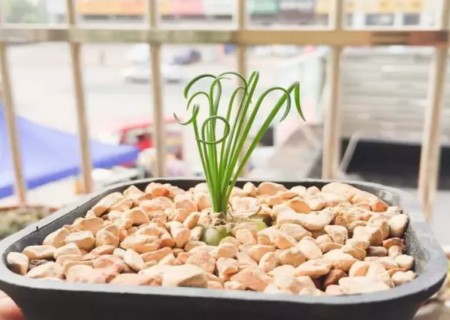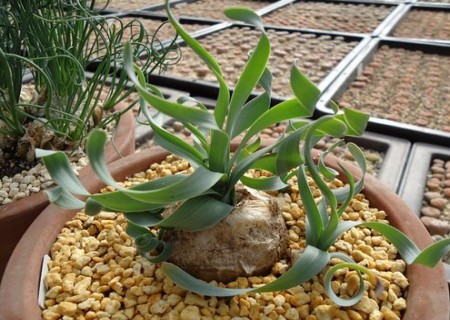How to raise potted spring grass
Today, we are going to talk about spring grass, this strange succulent plant looks like springs and weeds, so "meat as its name", leaves like a spiral upward growth, the recent rise of small miniature potted plants, there is a kind of chic and fresh, flowering is very elegant, put on the balcony, windowsill is very good!
Spring grass, also known as spiral grass, gets its name because its leaves are twisted and shaped like springs. it is a small potted ornamental plant newly introduced in recent years, with unique shape, simple bulbs, leaves according to different varieties, or like springs, or like kelp floating in the water, or like long curly hair, or like iron products, its lines are smooth and elegant, rich in variety, elegant and fresh in color, suitable for planting in small pots, embellished in windowsills, several cases, etc. Strange and interesting.

The main points of daily maintenance of potted spring grass on balcony:
1. Management of the four seasons
Spring grass likes cool and hot, 10 ℃ ~ 20 ℃ is the best in winter, and no less than 0 ℃ can survive the winter safely. In the middle and last ten days of May, with the increase of temperature, the leaves on the ground gradually withered, the plant went into a dormant state, the dry leaves could be removed, the bulbs were left in the original pot for summer, and the flowerpot should be placed in a dry, ventilated and water-free place. When it turns cool in autumn, new buds will grow out of the bulbs and slowly resume management. Dormant in summer, there can be no water in summer, or they can be slightly moist, and the leaves will dry up, but the bulbs will still grow. Don't water them in the center of the dry leaves. After summer, the bulbs will grow a lot bigger.
2. Lighting
Spring grass likes light, the growing period should be given sufficient light, if the lack of light will make the leaves weak, and the degree of curl is poor, it is difficult to highlight the unique charm of spring grass. The leaves of plants growing in sufficient sunshine are low and stout, twisted and twisted, with high ornamental value, but sunshade nets should still be built after April to avoid hot sun exposure and prevent leaf tips from drying up.
3. Watering
Spring grass likes the humid environment, it is appropriate to keep the soil moist during the growing period without stagnant water. If long-term drought and lack of water, the plant will not die, but the growth will stagnate, the leaves will yellowing, and even withered; while long-term stagnant water in the basin soil will cause bulb rot. Cool weather can often spray water on the plants, increase air humidity and prevent the top of the leaves from drying up. In summer, in order to avoid flooding in the rainy season, the flowerpot can be placed on the shelf or on a stage with a certain height, and pay attention to control watering to prevent the bulb from rotting due to stagnant water, but the pot soil can not be completely dry to prevent the bulb from drying up.
4. Fertilization
The peak period of plant growth is from October of each year to April of the following year. Mature thin liquid fertilizer or compound fertilizer is applied once a month to provide sufficient nutrients to make the plant grow vigorously. After the flower is extracted in spring, 0.5% potassium dihydrogen phosphate solution is sprayed 2 to 3 times to promote flowering.
5. Pollination
After flowering, spring grass should select different plants for artificial pollination (cross-plant pollination) to make the plants bear fruit, and pay attention to harvesting the seeds after maturity, so as not to make them scattered; if there are no seeds, the remaining pedicels should be cut off in time after flowering so as not to consume too much nutrients.
6. Change the basin
Spring grass is generally changed once a year at the end of August, the basin soil requires fertile and loose, rich in humus, with good drainage and permeability, can be mixed with 3 portions of saprophytic soil or peat soil, 2 parts of vermiculite or sandy soil, and mixed with a small amount of bone powder. Cut off the rotten root system when changing the basin, plant the bulb out of the soil 1 / 3 or so, pour water after planting and maintain it in a place with sufficient light. After that, pay attention to keep the soil moist, and soon new leaves will grow from the top of the bulb.
7. Pest control
There are not many diseases and insect pests in spring grass, and the main pests are snails and nematodes in the soil. When planting, the soil can be treated with high temperature to kill the pests and eggs in the soil. The main diseases of spring grass are bulb rot caused by long-term stagnant water due to poor soil permeability, and leaf tip dryness caused by dry air, long-term lack of soil water and other factors, which can be prevented by improving the cultivation environment.
The characteristics of each flowering period and pay attention to the details:
1. Prophase of flowering
The peak period of plant growth is from October of each year to April of the following year. Mature thin liquid fertilizer or compound fertilizer is applied once a month to provide sufficient nutrients to make the plant grow vigorously. After the flower is extracted in spring, 0.5% potassium dihydrogen phosphate solution is sprayed 2 to 3 times to promote flowering.
2. Near flowering
Pedicels are drawn from leaves, racemes, florets drooping, petals light yellow on the front and yellowish green on the back, some varieties have a light and elegant fragrance, the flowers generally open when there is plenty of sunshine, close in the evening, so that the day opens and the night closes. A single flower can bloom for about 5 days, but it is difficult to bloom in rainy days or insufficient light in the cultivation environment, and the florescence is from February to April.
3. Characteristics of flowering time
Spring grass has a unique shape, different varieties of leaves or like springs, or like kelp in the water, or like curly long hair, etc., its lines are smooth, elegant, rich in variety, elegant and fresh, suitable for small pot planting, embellished in windowsill, several cases, strange and interesting.
4. Late flowering stage
After flowering, different plants should be selected for artificial pollination to make the plants bear fruit, and the seeds should be harvested after maturity so as not to scatter them; if there are no seeds left, the remaining pedicels should be cut off in time after flowering so as not to consume too much nutrients.
After the spring grass blossoms, the ground part will gradually wither, the corms will grow dormant in summer, the withered parts can be cut off, the bulbs and flowerpots will be placed in a cool and moist place, occasionally watered to keep the soil slightly moist, and the corms will continue to expand. When autumn comes, new leaves will sprout, and now put them on the windowsill for normal maintenance.
Time: 2019-05-31 Click:
- Prev

Culture methods of potted Osmanthus fragrans
The four seasons sweet-scented osmanthus is a precious flower in China, which not only has a wide range of viewers, but also has high economic value. It is deeply loved by people. Its flowers are beautiful and fragrant, and they are often planted as landscape trees with high appreciation value. Friends who like sweet-scented osmanthus can also put sweet-scented osmanthus trees as potted plants in the living room.
- Next

How to raise broad-leaf spring grass
After months of deep sleep, although the temperature is already cool, my broad-leaf spring grass just spit out new leaves today. From the point of view of the time of budding, my budding time is much later than that of other flower friends, whether in Dalian or in the south.
Related
- Fuxing push coffee new agricultural production and marketing class: lack of small-scale processing plants
- Jujube rice field leisure farm deep ploughing Yilan for five years to create a space for organic food and play
- Nongyu Farm-A trial of organic papaya for brave women with advanced technology
- Four points for attention in the prevention and control of diseases and insect pests of edible fungi
- How to add nutrient solution to Edible Fungi
- Is there any good way to control edible fungus mites?
- Open Inoculation Technology of Edible Fungi
- Is there any clever way to use fertilizer for edible fungus in winter?
- What agents are used to kill the pathogens of edible fungi in the mushroom shed?
- Rapid drying of Edible Fungi

